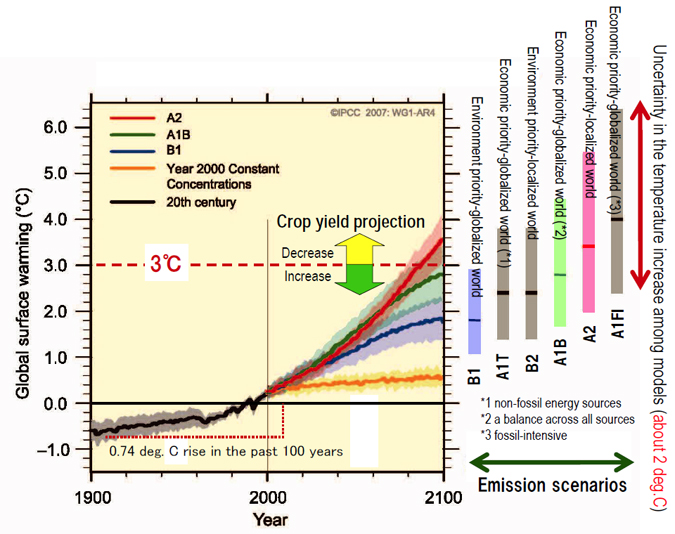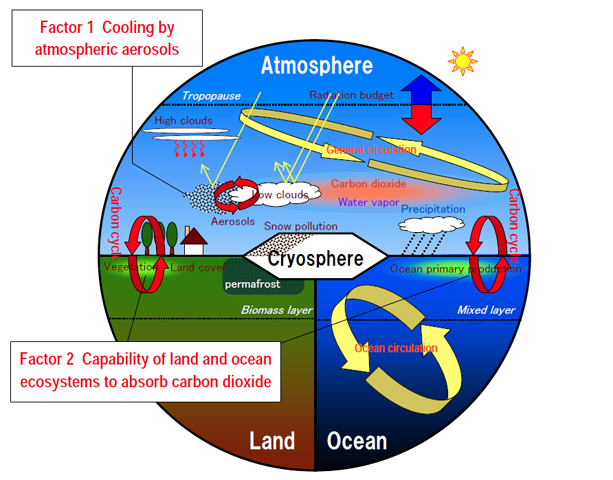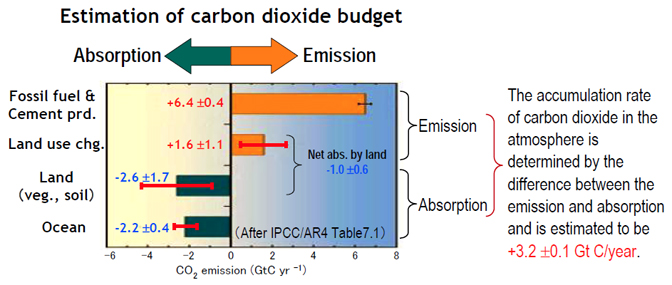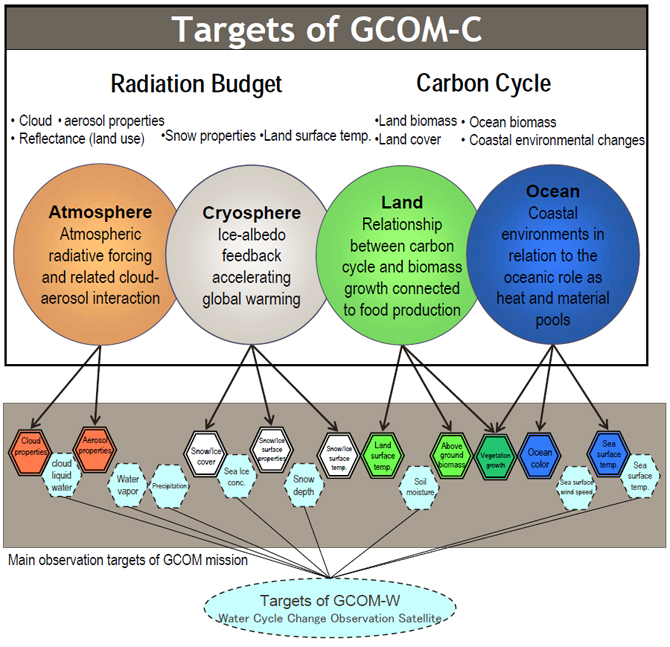Objectives and Targets
Uncertainty in current predictions of the air temperature increase
Global averaged air temperature has recently been rising. According to the fourth assessment report published by the Intergovernmental Panel on Climate Change (IPCC) in 2007, the temperature increase is expected to continue throughout this century (see figure below). However, uncertainties in the temperature predictions are still quite large about 2 degree Celsius. The uncertainties result from the difference in the implementation method of individual physical processes among different climate models.

- Multi-model global averages of surface warming (relative to 1980~1999) for scenarios A2, A1B and B1, shown as continuations of the 20th century simulations. Shading denotes the ±1 standard deviation range of individual model annual averages. Source: IPCC Fourth Assessment Report, Summary for Policy Makers.
The environmental effect of the air temperature increase can differ significantly depending on whether the increase exceeds 3 degrees C or not. For example, if the increase does not exceed 3 degrees C., crop yield is projected to increase. However, if the temperature increase exceeds 3 degrees, crop yield is expected to drop. It is thus necessary to choose an appropriate emission scenario and to precisely predict temperatures in order to prevent the air temperature from rising beyond 3 degrees C. in the future.
Factors affecting the accuracy of future air temperature prediction
The large uncertainties in air temperature prediction among current climate models originate from the fact that we do not fully understand the behavior of the individual sub-systems of the Earth in the future warmed world, i.e., the atmosphere, ocean, and land that affect the climate system. In particular, the cooling effect of atmospheric aerosols *1 and the capability of land and ocean ecosystems to absorb carbon dioxide are two main factors to be investigated.
※1: Cooling effect of the aerosols : Aerosols can scatter sunlight directly or indirectly through interaction with clouds that can scatter the light more effectively back into space. As a result, solar radiation reaching the ground can be reduced and thus the surface becomes cooler.

- Sub-system components composing the climate system
Factor 1: Cooling by atmospheric aerosols

- Global average radiative forcing (RF) estimates and ranges in 2005 for anthropogenic carbon dioxide (CO2), methane (CH4), nitrous oxide (N2O) and other important agents and mechanisms, together with the typical geographical extent (spatial scale) of the forcing and the assessed level of scientific understanding (LOSU). The net anthropogenic radiative forcing and its range are also presented. Source: IPCC Fourth Assessment Report, Summary for Policy Makers.
The above figure indicates global average forcing of greenhouse gases (GHGs) and aerosols. While the forcing of heating factors such as GHGs is estimated with low uncertainties, those of aerosols are considered to provide direct and indirect cooling effects; altering the effect of cloud albedo through cloud microphysical process is considered an indirect effect. However, uncertainties in the estimate of the cooling effect are still large. In addition, some theoretical studies tell us that cloud distributions in the warmed world will change and cause heating, not cooling, but predictions of the cloud radiative forcing by current climate models are scattered in both cooling and heating directions. GCOM-C aims to observe long-term trends of horizontal distributions of aerosols and clouds on a global scale over 13 years and to estimate the cooling effects of aerosols with high accuracy in order to contribute to enhancing the accuracy of climate models.
Factor 2: Capability of land and ocean ecosystems to absorb carbon dioxide

- Contributions of human-caused sources (orange) and natural sinks (green) to the changes in atmospheric greenhouse gas concentrations.Source: IPCC Fourth Assessment Report, Working group-I.
Land and ocean currently act as natural sinks of carbon dioxide (CO2) through ecosystem activities and prevent the rate of its accumulation in the atmosphere from increasing. However, there are still large uncertainties in the current estimation of CO2 absorption. A further unknown factor is the persistency of the ability of land and ocean to absorb CO2 in a warmed world.
GCOM-C aims to conduct long-term observations to monitor the distributions of land and oceanic vegetation and global surface temperature in order to understand the absorption and emission processes of CO2 by the ecosystem and to contribute to improving land and ocean processes in numerical climate models.
Observation targets of GCOM-C
GCOM-C will observe various geophysical parameters related to the global climate system, as a follow-on of ADEOS/OCTS and ADEOS-II/GLI. Also, GCOM-C will have an enhanced capability to observe land aerosols and biomass, which are necessary parameters for improving numerical climate models but have not been observed with enough accuracy.
